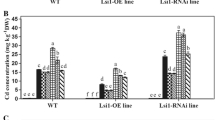Abstract
Silicon (Si) is a beneficial element for healthy growth and high and sustainable production of rice, but the mode of action of the beneficial effects has not been well understood. We carried out field trials for four years at two different locations to re-examine the effects of Si on the growth and production of rice using a low silicon rice (lsi1) mutant. The mutant accumulated much lower Si at each growth stage compared with the wild-type rice (Oryza sativa L. cv Oochikara), but there was no difference in the accumulation of other nutrients including N, P, and K. Measurements at different growth stages showed that low Si in the mutant hardly affected the tiller number, chlorophyll content (SPAD value), and root growth. The plant height and shoot dry weight of the wild-type rice were slightly higher than those of the mutant at a later growth stage, but the difference was not significant between the two lines. However, grain yield was reduced by 79–98%, depending on year, due to a low Si accumulation in the mutant, which showed the largest effect of Si on rice production among all studies reported so far. Among the yield components, the percentage of filled spikelets was mostly affected, being only 13.9% of the wild-type rice in the mutant. The grain color of the mutant became brown because of excessive transpiration and infection of pathogens. These results indicate that Si increases rice yield mainly by enhancing the fertility of spikelets.








Similar content being viewed by others
References
Datnoff LE, Rodrigues FÁ (2005) The role of silicon in suppressing rice diseases. APSnet Features February 2005
Epstein E (1994) The anomaly of silicon in plant biology. Proc Natl Acad Sci U S A 91:11–17
Epstein E (1999) Silicon. Annu Rev Plant Physiol 50:641–664
Fauteux F, Remus-Borel W, Menzies JG, Belanger RR (2005) Silicon and plant disease resistance against pathogenic fungi. FEMS Microbiol Lett 249:1–6
Ma JF (2004) Role of silicon in enhancing the resistance of plants to biotic and abiotic stresses. Soil Sci Plant Nutr 50:11–18
Ma JF, Takahashi E (2002) Soil, Fertilizer, and Plant Silicon Research in Japan. Elsevier Science, Amsterdam
Ma JF, Yamaji N (2006) Silicon uptake and accumulation in higher plants. Trend Plant Sci 11:392–397
Ma JF, Nishimura K, Takahashi E (1989) Effect of silicon on the growth of rice plant at different growth stages. Soil Sci Plant Nutr 35:347–356
Ma JF, Goto S, Tamai K, Ichii M (2001) Role of root hairs and lateral roots in silicon uptake by rice. Plant Physiol 127:1773–1780
Ma JF, Tamai K, Ichii M, Wu GF (2002) A rice mutant defective in Si uptake. Plant Physiol 130:2111–2117
Ma JF, Tamai K, Yamaji N, Mitani N, Konishi S, Katsuhara M, Ishiguro M, Murata Y, Yano M (2006) A silicon transporter in rice. Nature 440:688–691
Ma JF, Yamaji N, Mitani N, Tamai K, Konishi S, Fujiwara T, Katsuhara M, Yano M (2007) An effulux transporter of silicon in rice. Nature 448:209–212
Sasamoto K (1958) Studies on the relation between the silica content in the rice plant and the insect pests. Part 6. Jpn J Appl Entomol Z 2:88–92
Savant NK, Snyder GH, Datnoff LE (1997) Silicon management and sustainable rice production. Adv Agron 58:151–199
Seo W, Ota Y (1982) Role of the hull in the ripening of the rice plant. Part 5. Water loss in hull and development of rice kernel. Jpn J Corp Sci 51:529–534
Takahashi E, Hino K (1978) Silica uptake by plant with special reference to the forms of dissolved silica. J Sci Soil Mature Jpn 49:357–360
Takahashi E, Arai K, Kashida Y (1966) Studies on the physiological role of silicon in corp plant. Part 14. J Sci Soil Mature Jpn 37:594–598
Yoshida S (1965) Chemical aspect of silicon in physiology of the rice plant. Bull Natl Agric Sci B 15:1–58
Acknowledgement
This work is supported by a Grant-in-Aid for Scientific Research on Priority Areas from the Ministry of Education, Culture, Sports, Science and Technology of Japan (no. 17078008 to J. F. Ma) and a grant from the Ministry of Agriculture, Forestry and Fisheries of Japan (Rice Genome Project IP-5003 to J. F. Ma). The authors thank lab members for their help in transplanting and harvesting rice.
Author information
Authors and Affiliations
Corresponding author
Additional information
Responsible Editor: Fangjie J. Zhao
Rights and permissions
About this article
Cite this article
Tamai, K., Ma, J.F. Reexamination of silicon effects on rice growth and production under field conditions using a low silicon mutant. Plant Soil 307, 21–27 (2008). https://doi.org/10.1007/s11104-008-9571-y
Received:
Accepted:
Published:
Issue Date:
DOI: https://doi.org/10.1007/s11104-008-9571-y




